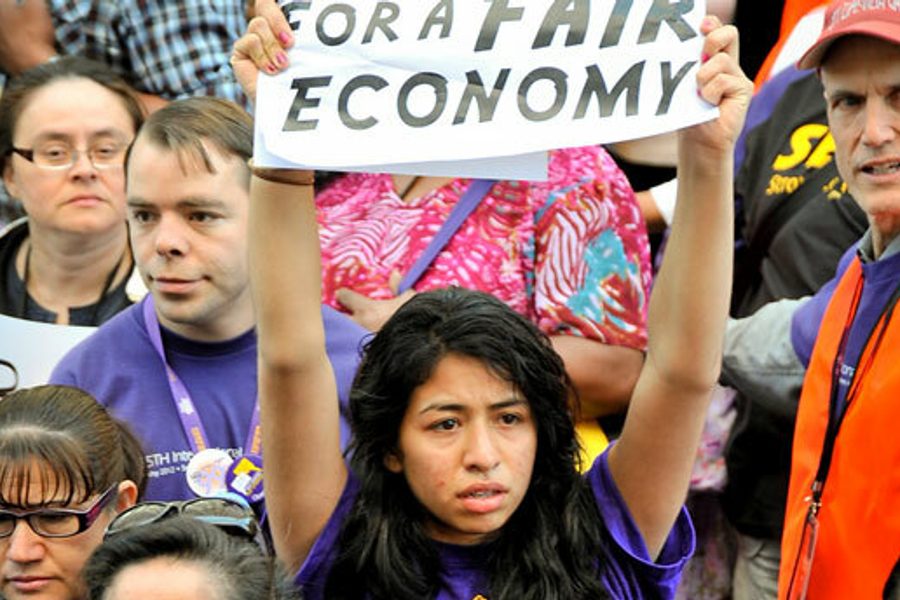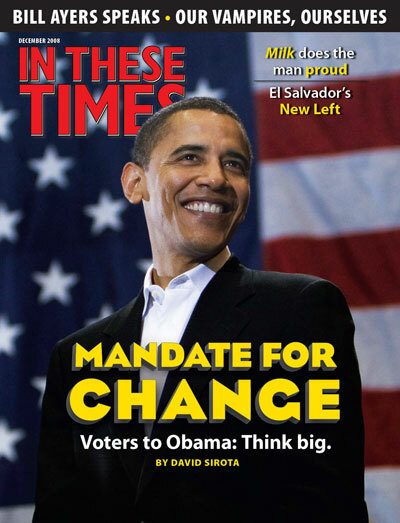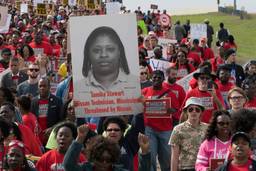Beyond Casino Capitalism
Bush let the gamblers run wild. Here’s how Obama can rein them in.
David Moberg

Typically, few people turn to dead French poets for economic analysis, but Stéphane Mallarmé proved wiser than many a billionaire financial trader when he wrote, “A throw of the dice will never abolish chance.” Translated into the prosaic language of the global economic crisis, his epigram might read, “Even the sale of more than $60 trillion in credit default swaps will never abolish the risk of crummy loans.”
Until recently, the wizards of Wall Street believed they had abolished – or at least “managed” – risk so well that they could turn the global economy into a casino. By playing the roles of both the gambler and the house, they were always guaranteed to come out the winner. In the process, they borrowed deeply and redoubled their bets, multiplying the risk inherent in a capitalist economy.
It worked for a while. In 2007, the financial sector reaped 40 percent of all U.S. corporate profits, as debt-driven speculation proliferated in a dizzying array of financial devices.
But now the financial edifice has crashed, spreading failure from subprime home loans to other mortgages, and endangering investment banks, commercial banks and insurers in the United States and Europe – and even whole countries, such as Iceland.
The contagion continues to spread to hedge funds, emerging markets, pension funds, state and local governments, credit card issuers, major corporations, and the rest of the more than $600 trillion financial derivatives market. That amount is roughly 11 times the value of the world’s annual production.
Former Federal Reserve Chairman Alan Greenspan now admits the failure of the ideology that governed the financial markets in recent decades. “I made a mistake in presuming that the self-interests of organizations, specifically banks and others, were such as that they were best capable of protecting their own shareholders and their equity in the system,” Greenspan told the House Oversight and Government Reform Committee on Oct. 23.
But the crisis has roots in the real economy, especially with regard to wage stagnation and growing income inequality.
When President-elect Barack Obama takes office in January, he will have to transform the failed model of casino capitalism into a more democratic, egalitarian and stable system. To do so, he will need to strengthen the role of government in providing direction for the real economy. But he will also need to make government the servant of the majority of working Americans, rather than an ally of corporations, or what University of Texas economist James K. Galbraith calls “the predator state.”
Beyond tougher regulation and simplifying the financial system, government needs to raise incomes and reduce inequality – thereby spreading the wealth around not only for the sake of fairness, but also simply to make the economy work better. It also needs to guide the economy toward innovative investments that create high-wage jobs, especially in the fields of energy efficiency and alternative technologies.
A brief history of financial disaster
Finance has triumphed over industry since the beginning of the 20th century, according to economic historian Lawrence Mitchell. But New Deal reforms – more financial system regulation, more government spending – tempered financial volatility for a quarter-century after World War II.
But University of Missouri economist Randall Wray argues in a paper for Bard College’s Levy Institute that the success spawned two destructive consequences: financial players sought new ways to get around regulations, and they became accustomed to the government preventing a new Depression.
Under what the late economist Hyman Minsky called “money manager capitalism,” new financial products and institutions undermined the role of traditional banking. Modern-day investors believed that the new economy would always head up, either through dot-com stocks, housing or some other vehicle.
In the early ’70s, the post-war Bretton Woods system of global financial management crumbled. A vast global pool of unregulated “Eurodollars” – or profits that global investors and companies did not repatriate to the United States – eroded the power of governments to regulate currencies. This financial globalization accelerated broader economic globalization – the dismantling of government regulation in favor of a free hand for large corporations. It also triggered the birth of financial derivatives, which are products that derive value from some underlying, real commodity (like a futures contract in Swiss francs).
Financial globalization also eventually opened up a wider market for financial securities. Banks were turning pools of mortgages into securities, so they could profit from originating loans but not have to keep loans on their books.
Mortgage brokers soon joined the game. They offered financial incentives to sign up high-risk borrowers, who yielded bigger fees for originating loans. It became a race to get these loans securitized and sold as quickly as possible.
Eventually, banks, hedge funds and insurance companies – like the bailed-out AIG – would also profit by selling derivatives, such as credit default swaps that were used as insurance against the risky securitized loans.
Yet these swaps were not real insurance. Issuers did not need to keep capital reserves, as insurance companies do, and many of the banks selling swaps also bought swaps, thus undercutting the rationale for getting the risk off their books.
Even worse, virtually nobody understood what the risks were, or how these investments should be valued. Rating agencies – such as Moody’s and Standard and Poor’s, whose AAA ratings justified buying the swaps – gave instructions to asset-backed securities issuers about how to package their most risky loans and still win top ratings. The issuers, in turn, paid the agencies handsomely.
What’s more, any product that could be used as a hedge to protect against risk could also be used to speculate.
Writes Wray: “A huge part of credit default swaps were not hedges but huge bets that bonds would go bad, that countries would go bad. Just pure gambling.”
Banks ended up carrying more risk than they had before securitization. The whole scam, Wray writes, “sucked away what little accumulated wealth low-income homebuyers had managed to put toward a down payment.”
The long slowdown
Over several decades, the financial industry has been increasingly parasitic. It has sucked wealth out of the rest of the economy, rather than facilitating investment in real growth.
The underlying problem, economic historian Robert Brenner argued in his 2002 book, The Boom and the Bubble, is a long-term slowdown in U.S. growth rates and a squeeze on profitability. That’s especially true in the manufacturing sector, where there is excess global capacity to produce goods in many industries.
As a result of that long slowdown, Brenner argues, the world economy increasingly relied on growing U.S. debt and financial bubbles. It also prodded corporations to hold down wages and increase profits – by busting unions, by shipping jobs overseas, by shrinking the social safety net, and by shifting tax burdens away from corporations and the rich.
The result? Since 1976, the after-tax income of the bottom one-fifth of American households has grown only 6.3 percent, while income for the top 1 percent has soared 228 percent. Nearly all the income gains in the most recent recovery went to the richest households. Over the past eight years, corporate profits grew at the expense of wages as a share of national income, and workers’ incomes were flat as productivity grew.
From 1969 to 2004, short-term family income volatility doubled, recently rising to a new peak, according to research for the Economic Policy Institute by Yale political scientist Jacob Hacker.
The casino economy hit home for working families with a vengeance. But the rich sought out ever-increasing profits from hedge funds, private equity firms, leveraged buy-outs, commodity speculation, and much more. Meanwhile, most Americans went deeper in debt to try to maintain their standards of living, as jobs grew slowly and domestic manufacturing investment slowed.
Rutgers University historian James Livingston finds all-too-close parallels between now and the beginnings of the Great Depression. He says that the Great Depression resulted not only from mismanagement of a routine business downturn, but also from “a massive shift of income shares to profits, away from wages and thus consumption, at the very moment – the 1920s – that expanded production of consumer durables became the crucial condition of economic growth.”
To avoid a new depression, Obama will need to stop any remaining financial panic. Most analysts of varied ideologies argue that governments can often halt panics by acting quickly and making loans – liquidity – readily available.
Impaired by their ideology, the Federal Reserve and the Bush administration acted more slowly than they should have. When they finally took more drastic action, they focused mainly on the bailout of financial institutions, not the economy.
In late September, Treasury Secretary Henry Paulson initially proposed an ineffective $700 billion plan to buy the banks’ worst assets. That was followed by a half-hearted Oct. 13 decision to invest $250 billion of the bailout directly in the nation’s banks – making the federal government part owner of many of these banks, including the largest.
But even as the United States became an owner, it – unlike many European governments – surrendered all ownership control, leaving the bailed-out companies essentially free to do whatever they want with the money. The government also overpaid for its share of the bailed-out institutions – paying double what investor Warren Buffet paid for his stake in Goldman Sachs, according to a steelworkers’ union analysis.
If the government had followed President Franklin Roosevelt’s example – or even the ’90s Swedish model – it would have taken over the banks, replaced the executives, and made the institutions solvent. This way the banks could have been ready to do their proper business, namely channeling savings to investment, whether under public, private or mixed control.
Many financial reforms are needed. First, a new administration must put all financial institutions under regulatory control and move all assets and liabilities on their balance sheets. Columbia University economist and Nobel winner Joseph Stiglitz argues that a financial products’ safety commission should oversee all innovations, but regulators should simply ban many derivatives. Financial stability should become a key goal for regulators, along with full employment and price stability.
Second, given the mysteries surrounding most of the financial world, regulators must ensure investment information is clear and comprehensive. To do this, Stiglitz argues for reforming many perverse incentives, banning exploitative practices and curbing risky business with “speed limits” on bank expansion. Other reformers propose more efforts by the Fed to restrain speculative borrowing or to require banks to increase capital reserves when the economy heats up.
Third, to diminish speculation and fund new public investment for development, the government – ideally as part of a global agreement – should impose a small tax – within 0.25 percent – on all financial transactions, as Nobel-winning economist James Tobin proposed in the ’70s.
In short, to reduce financial risk, the government will have to steer capital away from risky, exploitative ends and toward profitable but socially productive ends.
More than market fixes needed
But fixing the casino economy involves more than better control over capital markets. There’s also a need to rebalance the real economy.
Most important is the need to relieve immediate pain: Provide help for distressed homeowners to stay in their homes – either as renters or as buyers, but under less onerous terms – and expand unemployment insurance to cover more workers longer and with more support.
A massive stimulus plan is also needed. But to create new jobs, it should downplay tax breaks and instead invest in infrastructure repair and new construction, support hard-pressed state and local governments, provide more money for education aid and basic research, and lead an energy efficiency campaign, with public and private employers retrofitting homes and public buildings.
Any stimulus plan should also be a prelude to a longer-term strategy to solve the failed casino economy’s core problem – the inequality and instability of most people’s incomes. That requires three government actions:
First, rebuild wage-raising labor market institutions – including unions.
Second, expand the social safety net, most immediately by creating universal health insurance.
Finally, tap new sources of long-term growth. The most promising project would be a massive effort for energy efficiency, new technologies (such as high-speed trains) and sustainable, safe alternative energy production.
Resolving the crisis requires global coordination, both in stanching the spread of the crisis and eventually in creating a new Bretton Woods agreement. It should focus on human development first, viewing trade and foreign investment simply as one tool among many for improving people’s lives.
Globalization under current rules has encouraged the casino economy. The alternative to its corporate-friendly trade pacts is not to eliminate trade pacts altogether, but rather to implement fair-trade pacts that coordinate growth to raise global standards of living.
The casino economy had its chance, and it crapped out.
David Moberg, a former senior editor of In These Times, was on staff with the magazine from when it began publishing in 1976 until his passing in July 2022. Before joining In These Times, he completed his work for a Ph.D. in anthropology at the University of Chicago and worked for Newsweek. He received fellowships from the John D. and Catherine T. MacArthur Foundation and the Nation Institute for research on the new global economy.








